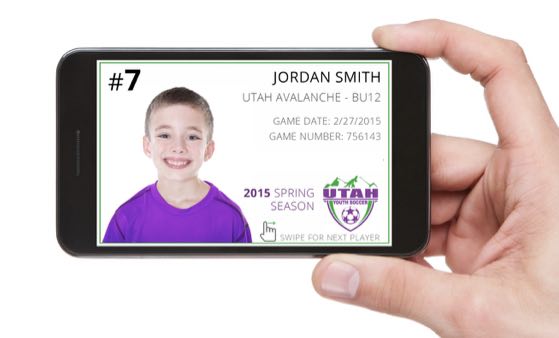Utah Kids and Families Enjoy the Benefits of Technology
 With a young and hip, text savvy population, Utah’s youth soccer coaches, youth soccer players and their families save trees and benefit from technology on and off the soccer field. In our modern world, big doses of data abound everywhere and are used to make our life easier. Our world has a 21st-century style of urgency, and we all adapt with ease to what our smart phones offer without hesitation or even a nod to the streamlined technology behind the screen.
With a young and hip, text savvy population, Utah’s youth soccer coaches, youth soccer players and their families save trees and benefit from technology on and off the soccer field. In our modern world, big doses of data abound everywhere and are used to make our life easier. Our world has a 21st-century style of urgency, and we all adapt with ease to what our smart phones offer without hesitation or even a nod to the streamlined technology behind the screen.
With 24/7 access to information, parents are often bewildered when entering the realm of youth soccer and wonder why they can’t use their cell phones to do more as a soccer parent.
With the help of Utah’s US Youth Soccer State Association, one of the fastest growing U.S. Youth Soccer associations, the youth soccer world embraces technology like it was oxygen.
One clear benefit: No longer is youth soccer in Utah confounded by the nightmare of paper player cards and the inherent threat of a team being disqualified from competition if those precious IDs are lost or stolen. In Utah, all you need is your smart phone and you are good to go. Ahh, the freedom that smart phones allow. If one can travel to Paris by showing their airline ticket on an iPhone, why do so many soccer loving Americans suffer in silence on soccer fields using last centuries’ old-fashioned player card systems? It is clearly time to adopt a smarter, easier system than laminated cards on a ring.
 “American youth soccer — in general — is in the dark ages. Most businesses embraced technology 10 years ago. Soccer is filled with mom and pop organizations staffed with volunteers who mean well but are not necessarily able to take advantage of what technology offers. We gave up paper player cards years ago. Utah’s population is highly educated and even laptops are old technology for us,” said Brian Smith, President of the Utah Youth Soccer Association.
“American youth soccer — in general — is in the dark ages. Most businesses embraced technology 10 years ago. Soccer is filled with mom and pop organizations staffed with volunteers who mean well but are not necessarily able to take advantage of what technology offers. We gave up paper player cards years ago. Utah’s population is highly educated and even laptops are old technology for us,” said Brian Smith, President of the Utah Youth Soccer Association.
Strong words for most of the country to hear, but heralded by Smith, who is clearly a smart visionary meeting the needs of his members. Smith is proud of his high per capita area with its diverse mix of people. “People come first, then technology supports the human effort,” said Smith who searched for the right people and then brought in the best technology on the market. “A goal of technology is to make everyone’s life easier,” said Smith, a business analyst, who selected Affinity Sports to run the state’s youth soccer association.
“Player cards are antiquated,” said Brian. “The youth soccer player birth certificates are loaded into the Affinity system and are securely protected – but not visible but confirmed – and any smart phone on the field can access the necessary information to check in a team and confirm the eligible players.”
Talking to coaches, tournament directors and team managers from across the country, everyone seems to relish the idea of letting technology improve youth soccer. “Everyone just uses a smart phone on the field and logs into our system,” said Smith. “It’s so much easier. Paper player cards are really a thing of the past and we cringe at people who are still using them. We remember that pain. Our parents, coaches, referees and everyone in our state loves having everything digital.”
Utah is also a big fan of online registration. The best part of all our registrations according to Utah State, is collecting all the money due. “We used to collect 70% to 80% of fees and then we had to go after and wait for the remaining balance,” Smith confessed. “With Affinity’s online system — parents login, pay their registration fees on the spot as they agree to our concussion policy and the parent code of ethics. We are now receiving 100% of our money and it’s all done with a lot less work.”
“In today’s numbers, we are collecting 25% more, roughly half-million dollars, on time and up front, that we would be without Affinity and their online electronic registrations,” continues Smith. It is just mystifying why youth soccer has taken so long to embrace making life simpler and more efficient. Technology has transformed accounts payable in many industries into a painless automated process. “Collecting funds is never fun. More youth soccer organizations would benefit from unburdening themselves from this problem,” said Smith.
What has slowed online youth soccer registrations from becoming popular? “Technology allows us to focus our efforts on soccer programs. It’s unfortunate that resistance to online registration is usually because it makes the registrar’s regular job obsolete,” said Brian. “I believe youth soccer club registrars can be retrained.”
 How did Utah resolve this barrier? Utah is a state with 62,972 players registered as of the 2013/2014 seasonal year – the 5th largest state association in Region IV and is ranked 20th out of the 55 state associations in the nation. Larger than Arizona, or Hawaii, Idaho, Montana, New Mexico and Nevada combined, Utah streamlined and automated their processes with ease, finding innovative solutions when needed.
How did Utah resolve this barrier? Utah is a state with 62,972 players registered as of the 2013/2014 seasonal year – the 5th largest state association in Region IV and is ranked 20th out of the 55 state associations in the nation. Larger than Arizona, or Hawaii, Idaho, Montana, New Mexico and Nevada combined, Utah streamlined and automated their processes with ease, finding innovative solutions when needed.
“The volunteers and paid professionals, who used to do the work of a registrar, are not burdened anymore by endless administrative paperwork. Now, they are available to assist clubs setting up their online systems and help managers, players, and parents. Not doing registration by paper is wonderful and so much more efficient,” said Smith.
Jokingly, Smith said, “We do not know what to do with all our extra time.” Of course, Utah spends this time now on improving programs for their players, which is the real focus of all youth soccer organizations – not the business of data entry and reminding parents to make payments.
 What is the best reason to adopt technology? When a soccer player suffers a concussion, there are important rules designed to protect the player’s health and youth soccer club’s liability. Why not let technology organize the data to make sure players who suffered concussions or injuries are cleared properly to return to play? After being cleared medically by a physician, software can confirm the player’s eligibility to return to play — all on a smart phone without the “I showed the letter from the doctor allowing my player to return to play to…” Affinity’s system, for example, has already enabled this feature and can do this today.
What is the best reason to adopt technology? When a soccer player suffers a concussion, there are important rules designed to protect the player’s health and youth soccer club’s liability. Why not let technology organize the data to make sure players who suffered concussions or injuries are cleared properly to return to play? After being cleared medically by a physician, software can confirm the player’s eligibility to return to play — all on a smart phone without the “I showed the letter from the doctor allowing my player to return to play to…” Affinity’s system, for example, has already enabled this feature and can do this today.
Transforming the business of soccer and infusing the game with technology is simply a matter of choice. We just have to get people to agree to let technology help. The time is now. The technology is available for the asking. As more Millennials become involved and push the lackluster Generation X out of the way and energize the aging Baby Boomers, there is hope that the youth soccer market can think more about what customers do and what they desire.
The only question is when will these benefits hit the field for more people in youth soccer? It’s a win-win we all can appreciate.







